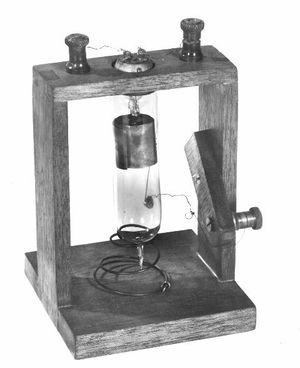Fleming Valve: Difference between revisions
From ETHW
No edit summary |
(CSV import of Timeline data) |
||
| (3 intermediate revisions by one other user not shown) | |||
| Line 1: | Line 1: | ||
'''''This article is a stub. You can help the | '''''This article is a stub. You can help the ETHW by expanding it.''''' | ||
[[Image:Fleming Diode 0351.jpg|thumb|right|Fleming Valve]] | [[Image:Fleming Diode 0351.jpg|thumb|right|Fleming Valve]] | ||
| Line 5: | Line 5: | ||
16 November 1904. London, England. Beginning in the 1880s Professor [[John Fleming|John Ambrose Fleming]] of University College London investigated the [[Edison Effect|Edison effect]], electrical conduction within a glass bulb from an incandescent filament to a metal plate. In 1904 he constructed such a bulb and used it to rectify high frequency oscillations and thus detect wireless signals. The same year Fleming patented the device, later known as the 'Fleming valve.' | 16 November 1904. London, England. Beginning in the 1880s Professor [[John Fleming|John Ambrose Fleming]] of University College London investigated the [[Edison Effect|Edison effect]], electrical conduction within a glass bulb from an incandescent filament to a metal plate. In 1904 he constructed such a bulb and used it to rectify high frequency oscillations and thus detect wireless signals. The same year Fleming patented the device, later known as the 'Fleming valve.' | ||
[[Category: | [[Category:Computing and electronics]] | ||
[[Category:Measurement]] | [[Category:Measurement]] | ||
[[Category:Electromagnetic_measurements]] | [[Category:Electromagnetic_measurements]] | ||
{{Timeline | |||
|Date=1/1/1904 | |||
|Priority=Electrical | |||
|Description=In 1904 in London, while investigating the Edison effect (electrical conduction within a glass bulb), John A. Fleming wired an old vacuum tube into a radio receiving circuit. A galvanometer could detect a weak wireless signal rectified by the Fleming Valve, which laid a foundation for electronics. | |||
}} | |||
Latest revision as of 06:49, 23 November 2017
This article is a stub. You can help the ETHW by expanding it.
16 November 1904. London, England. Beginning in the 1880s Professor John Ambrose Fleming of University College London investigated the Edison effect, electrical conduction within a glass bulb from an incandescent filament to a metal plate. In 1904 he constructed such a bulb and used it to rectify high frequency oscillations and thus detect wireless signals. The same year Fleming patented the device, later known as the 'Fleming valve.'
